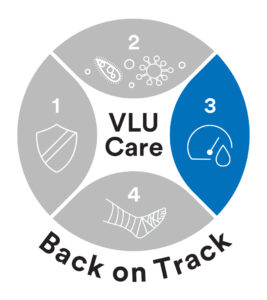
Venous leg ulcers (VLUs) are the most prevalent type of lower extremity wound. With incidence approaching 1% of the population1, most outpatient wound clinics are well versed in the treatment of VLUs.
In many cases VLU treatment plans look something like this:
- Assess the patient.
- Assess the wound.
- Identify and address contributing factors and comorbidities.
- Create a treatment plan incorporating wound bed preparation (including debridement), skin protection, exudate management and compression.
The result? After 12 weeks the wound heals. End of story.
Or is it?
A study published by Dr. Caroline Fife in 2018 examining outcome data from the U.S. Wound Registry found only 44% of VLUs healed by week 122. Another dive into retrospective data studied over 59,000 venous leg ulcers treatment episodes. Results showed that 21% of VLUs never had healing documented as a final endpoint3.
The variables at play
What variables prevent VLUs from healing in an expected timeframe (or at all)? Research provides insight into which VLUs are the most challenging to heal. Healing is negatively impacted when:
- Ulcers are large or old.
- There is a history of past ulcers or complicated venous disease.
- There is a lack of therapeutic compression4,5.
Additional factors such as advanced age, limited mobility, poor nutrition, a history of recent hospitalization or signs/symptoms of infection also complicated healing3,4,6. None of this is a surprise to experienced wound care clinicians. But other considerations may be less obvious.
By the time most VLUs are assessed by a wound care specialist they are truly “chronic” wounds. The average age at initial assessment is five months3. In addition to assessing and addressing the factors impacting healing mentioned earlier, it is necessary to consider the wound environment itself.
Chronic wound considerations
“Protracted inflammation” refers to a wound that is stuck in the inflammatory phase. In a normal healing process, the inflammatory phase cleans up cellular, extra-cellular and pathogen debris and lasts 2-5 days. In chronic wounds, due to the presence of biofilm, repeated trauma and underlying comorbidities, among other things – inflammation persists.
At a cellular level a war is raging. The body’s immune response is in action – neutrophils and macrophages are signaled. They secrete proteases (a protein-degrading enzyme), reactive oxygen species (ROS) and inflammatory cytokines7. This process is essential to keeping the wound base clean and free from infection. But when prolonged, it interferes with growth factor function and degrades the extracellular matrix. Healing is delayed.
What can be done to address protracted inflammation and set the stage for VLU healing?
- Start with debridement. The body’s effort to remove of nonviable tissue, debris and associated bacteria begins the inflammatory phase and this process continues until the wound bed is clean. Debridement of the wound as part of wound bed preparation will assist with this process and support the transition beyond inflammation. Surgical debridement is most efficient, but depending on the clinical situation, other forms such as soft mechanical debridement or chemical debridement may be considered.
- Manage the biofilm/bioburden. The presence of bioburden or biofilm exacerbates inflammation. Since most chronic wounds are found to have biofilm, consider routine, short-term use of an antimicrobial dressing that is effective on biofilm (not just planktonic bacteria).
- Topical dressing selection. Certain types of wound dressings, such as collagen, have been found to have a positive impact on the wound environment. They create a moist interface with the wound bed and create an environment conducive to granulation tissue development and epithelization.
- Reduce trauma. Inflammation can be triggered by recurrent trauma to the wound and surrounding tissue. In the case of VLUs, this may originate with the difficult application of compression stockings or repeated bumping of the wound area.
- Address confounding conditions. Comorbidities including diabetes and tissue hypoxia can lead to leukocyte dysfunction, creating an ineffective and prolonged inflammatory response2.
Improving the healing rates of VLUs involves a comprehensive approach. Creating a plan to counter the detrimental effects of protracted inflammation is an important piece of the puzzle.
References:
1 Harding K, et al. Simplifying venous leg ulcer management. Consensus recommendations. Wounds International 2015. Available to download from woundsinternational.com
2 Fife, C. E., Eckert, K. A., & Carter, M. J. (2018). Publicly Reported Wound Healing Rates: The Fantasy and the Reality. Advances in wound care, 7(3), 77–94. https://doi.org/10.1089/wound.2017.0743
3 Fife, C. (2018). From the Editor: The Need for Real Venous Ulcer Data. Today’s wound clinic. 12(2).
4 Parker CN, Finlayson KJ, Shuter P, Edwards HE. Risk factors for delayed healing in venous leg ulcers: a review of the literature. Int J Clin Pract. 2015;69(9):967-977. doi:10.1111/ijcp.12635
5 Fife, C. E., & Horn, S. D. (2020). The Wound Healing Index for Predicting Venous Leg Ulcer Outcome. Advances in wound care, 9(2), 68–77. https://doi.org/10.1089/wound.2019.1038
6 Parker CN, Finlayson KJ, Edwards HE. Predicting the likelihood of delayed venous leg ulcer healing and recurrence: development and reliability testing of risk assessment tools. Ostomy Wound Manage. 2017;63(10):16-33. doi: 10.25270/owm.2017.1633
7 Zhao, R., Liang, H., Clarke, E., Jackson, C., & Xue, M. (2016). Inflammation in Chronic Wounds. International journal of molecular sciences, 17(12), 2085. https://doi.org/10.3390/ijms17122085
